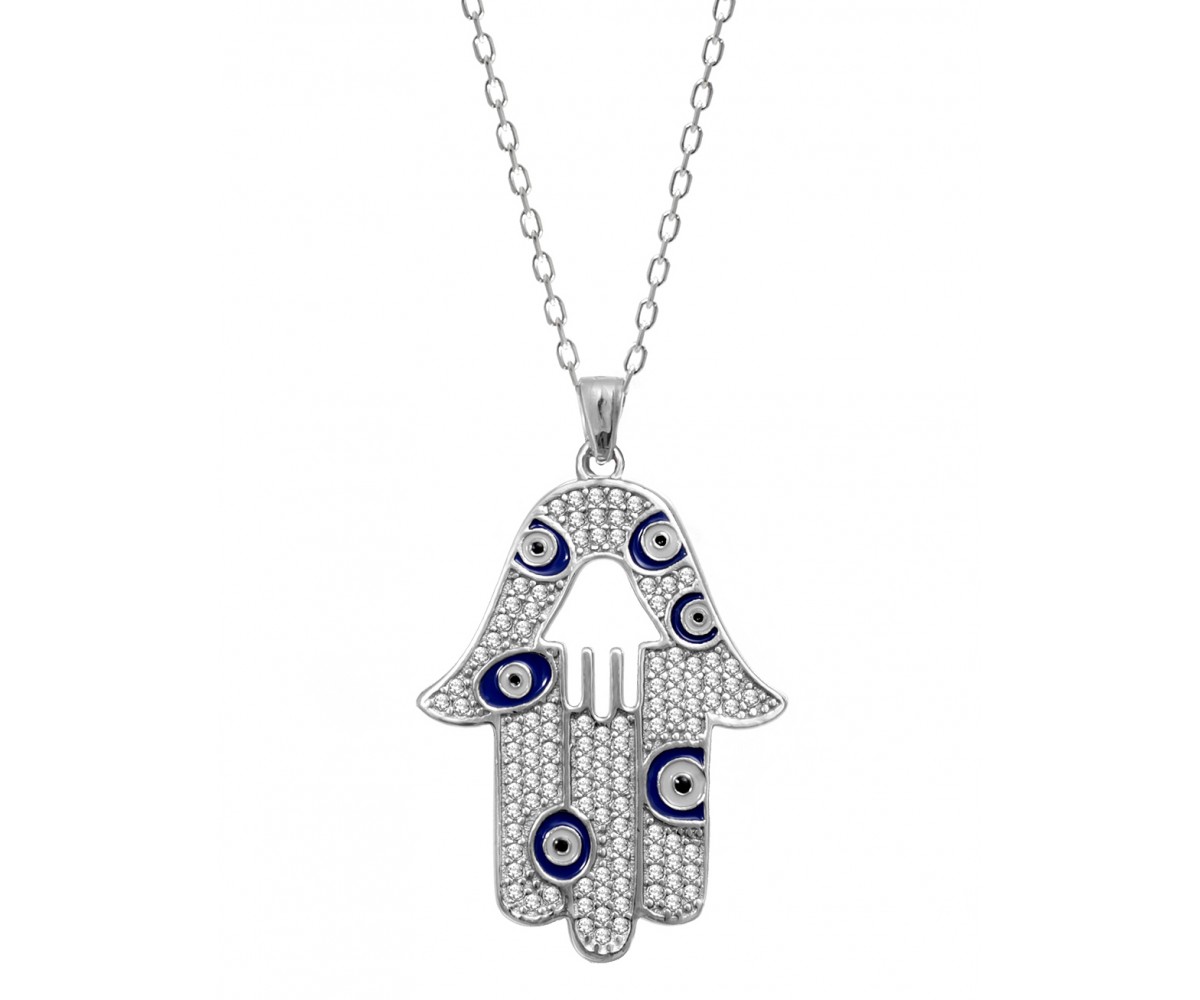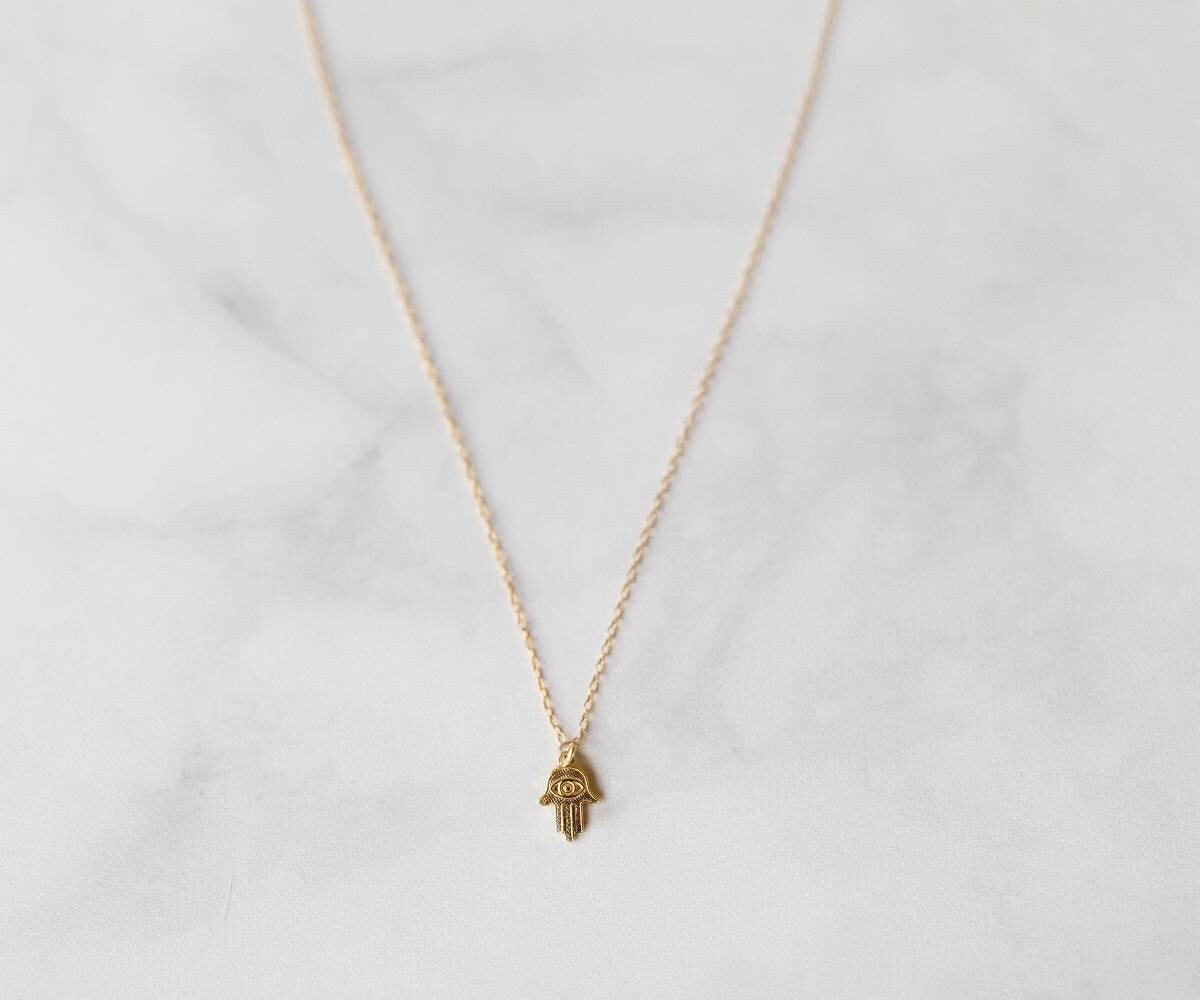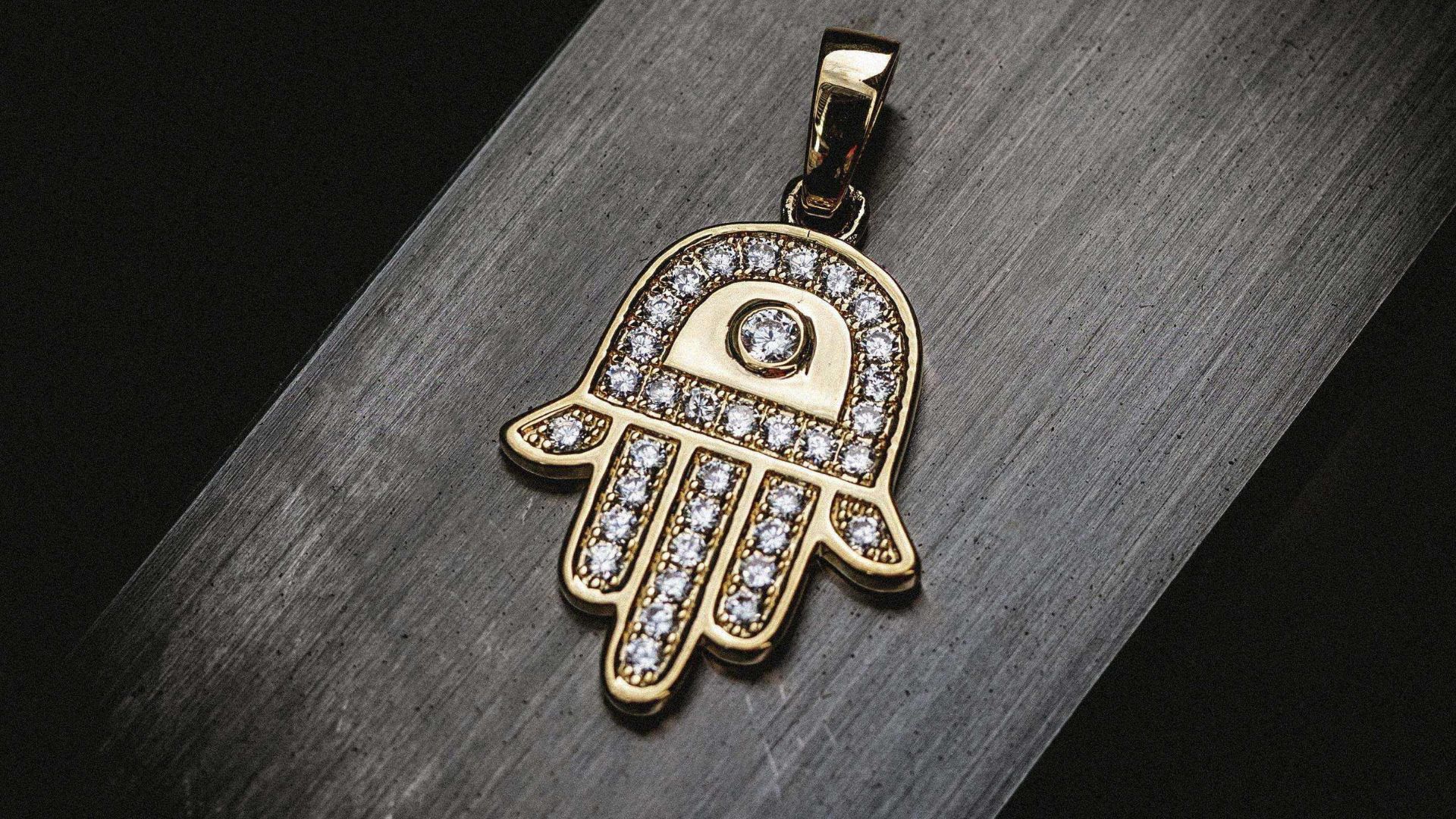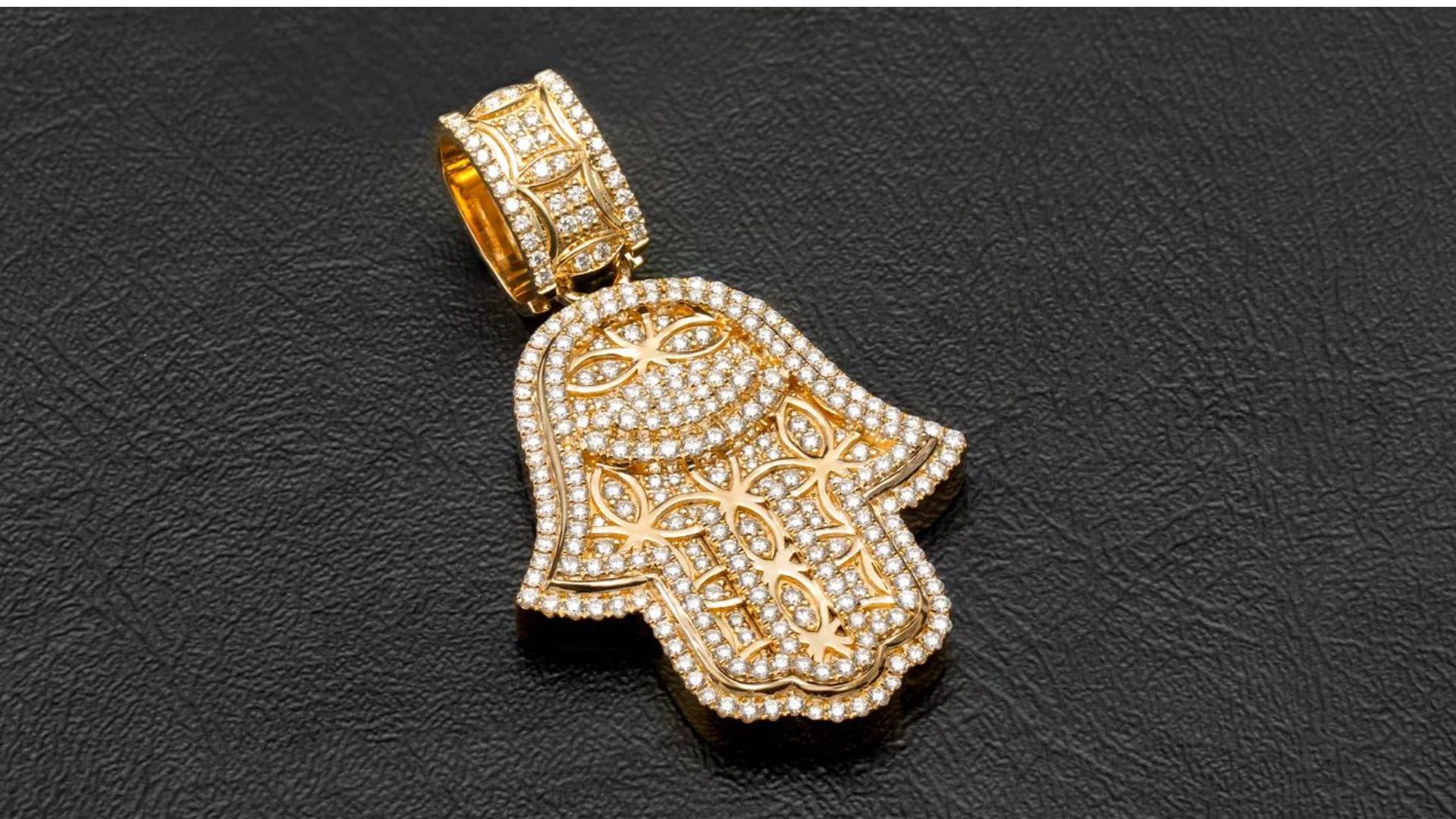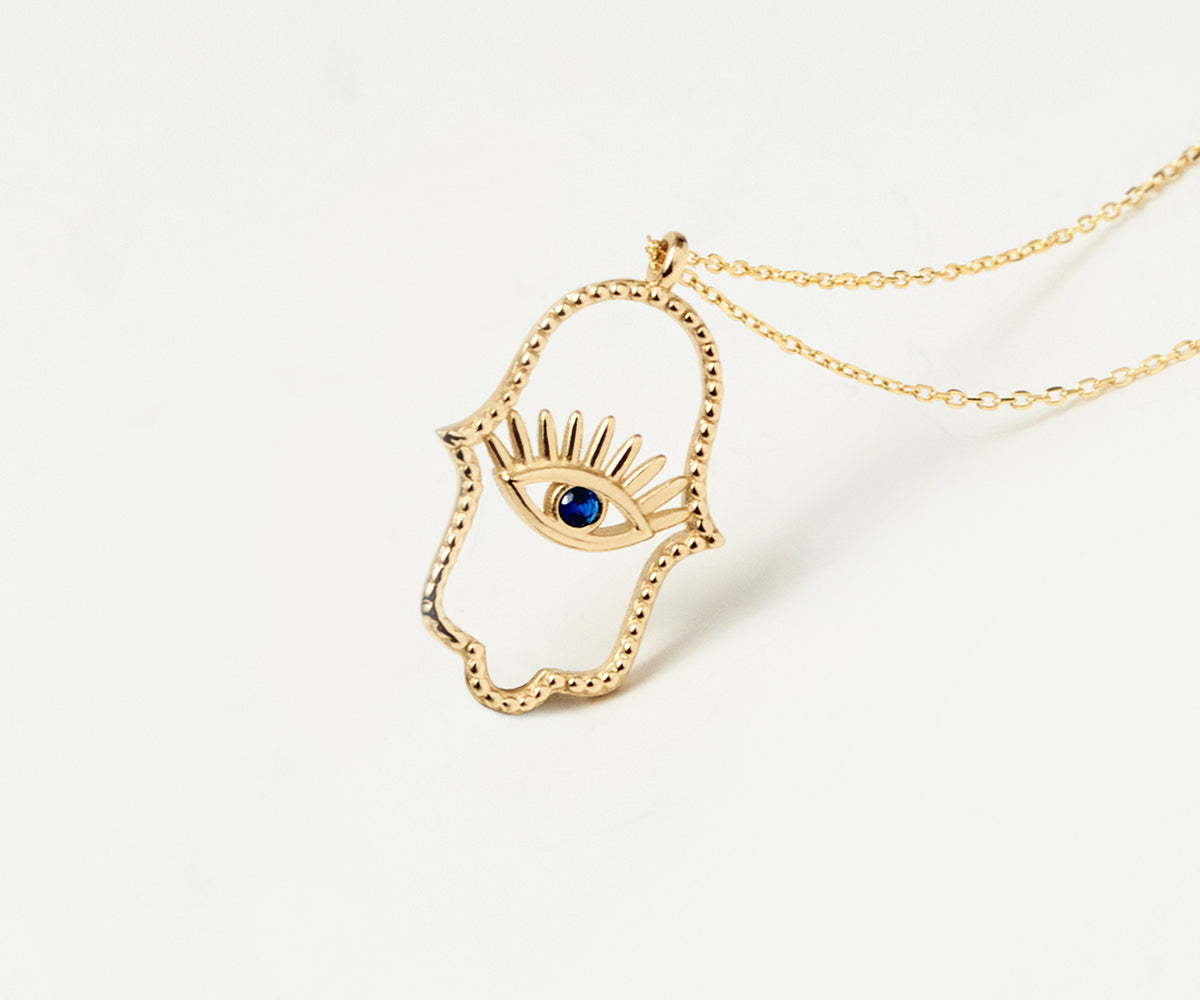
The world of jewelryis replete with symbols and talismans that have been worn for centuries, not just as adornments but as protective amulets too. Among these, the Hamsa hand pendants for protectionare often believed to ward off evil forces and negative energies.
In this exploration of Hamsa hand pendants, we delve into their history, symbolism, cultural significance, and how they serve as not just fashion statements but also as guardians against adversity. Originating from the Middle East and North Africa, the Hamsa hand is a palm-shaped amulet featuring an eye at its center.
The name 'Hamsa' itself is derived from the Arabic word for "five," representing the five fingers of the hand. The eye at the center is often referred to as the "Evil Eye," a belief that negative energies can be warded off through its protective gaze.
Hamsa Hand Pendants For Protection Through History
The Hamsa hand is an old sign that has gained popularity around the world due to its association with good luck, protection, and spirituality. It is thought to have originated in the Middle East and North Africa, where it is also known as the Hand of Fatima, the Hand of Mary, or the Hand of Miriam.
This article will look into the significance and popularity of the Hamsa hand, as well as its history and the myths that surround it. The Hamsa hand represents the triumph of good over evil, and its popularity stems from its capacity to shield against bad energies like the "evil eye." It is commonly portrayed as a hand with five fingers, representing the five pillars of Islam.
Ancient Origins And Cross-Cultural Significance
The origins of the Hamsa hand pendant are deeply rooted in antiquity. While it is widely associated with Middle Eastern and North African cultures, its inception can be traced back to ancient civilizations such as the Phoenicians and Carthaginians.
In these ancient societies, the Hamsa hand was revered as a potent protective symbol, believed to ward off malevolent forces and curses.
Jewish Mysticism And The Hamsa
Within the realm of Jewish mysticism, the Kabbalah, the Hamsa hand took on additional layers of symbolism and meaning. It became known as the "Hand of God" and was associated with divine protection.
Its five fingers came to represent the five books of the Torah, and its central eye symbolized God's watchful gaze over His people. The Hamsa hand pendant became a cherished talisman among Jewish communities, symbolizing faith, hope, and spiritual connection.
Islamic Influences And The Hand Of Fatima
In Islamic culture, the Hamsa hand is referred to as the "Hand of Fatima," named after the daughter of the Prophet Muhammad. The Hamsa hand pendant carries profound significance in Islam, signifying protection, blessings, and the power to ward off evil. It is often displayed in homes and worn as jewelry, with the belief that it safeguards against the "Evil Eye" and negative energies.
Global Spread And Adaptation
As trade routes expanded and cultures intermingled, the Hamsa hand pendant journeyed far beyond its place of origin. It found its way into diverse cultural contexts, undergoing adaptations and variations along the way.
In India, for instance, the Hamsa hand merged with Hindu symbolism, resulting in pendantsthat incorporate sacred symbols like the Om symbol and the lotus flower.
Victorian Era Revival
During the Victorian era, there was a resurgence of interest in mysticism and spirituality. The Hamsa hand pendant experienced a revival as part of the broader fascination with esoteric symbols and beliefs.
Victorian-era jewelry often featured the Hamsa hand, adorned with intricate designs and gemstones, appealing to those seeking both protection and aesthetic beauty.
Modern Interpretations And Contemporary Appeal
In the 21st century, the Hamsa hand pendant has transcended its historical and cultural boundaries to become a global symbol of protection and spirituality. It is celebrated not only for its symbolism but also for its aesthetic versatility.
Hamsa hand pendants are crafted from various materials, including gold, silver, and even more affordable options like stainless steel, making them accessible to a wide range of individuals.
Symbolism And Cultural Significance Of Hamsa Hand
The Hamsa hand, a mystical and captivating symbol, carries profound symbolism and cultural significance across various societies. In this section, we will delve deeper into the intricate meanings and cultural associations that have made the Hamsa hand a cherished emblem throughout history.
A Shield Against The Evil Eye
At its core, the Hamsa hand is often considered a potent shield against the malevolent influence of the "Evil Eye." The concept of the Evil Eye transcends cultural boundaries and has been a common belief in many civilizations. The Hamsa hand, with its vigilant central eye, is believed to absorb and deflect harmful glares, protecting the wearer from envy, ill-wishing, and negative energy.
Universal Symbol Of Protection
One of the most remarkable aspects of the Hamsa hand is its universal appeal. While it has strong roots in Middle Eastern and North African cultures, it has found resonance across the globe. The Hamsa hand transcends religious affiliations, serving as a symbol of protection and good fortune embraced by individuals of different faiths, including Islam, Judaism, Christianity, and Buddhism.
The Hand Of Fatima In Islamic Tradition
In Islamic tradition, the Hamsa hand is known as the "Hand of Fatima," honoring the daughter of the Prophet Muhammad. It is deeply revered and symbolizes not only protection but also divine blessings and guidance. Many Muslims believe that wearing the Hamsa hand pendant strengthens their connection to God and safeguards them from harm.
The Hand Of Miriam In Judaism
Within Jewish culture, the Hamsa hand is often referred to as the "Hand of Miriam," celebrating the protective and nurturing qualities associated with women. It serves as a symbol of faith, strength, and the ability to overcome adversity. Jewish tradition holds that the Hamsa hand pendant brings blessings and safeguards the home from negative energies.
Hindu Influences In India
In India, the Hamsa hand took on new dimensions as it merged with Hindu symbolism. The open palm design became associated with various deities, including Lord Ganesha, the remover of obstacles, and Saraswati, the goddess of knowledge. This fusion of cultures and beliefs resulted in unique Hamsa hand pendants adorned with intricate Hindu symbols.
Mystical Elements - The Five Fingers
The five fingers of the Hamsa hand hold additional layers of symbolism. In some interpretations, each finger represents an element earth, water, fire, air, and ether connecting the wearer to the natural world and its forces. Others associate the fingers with the five senses or the five pillars of Islam, imbuing the pendant with even greater significance.
Contemporary Fashion And Style
In the ever-evolving world of fashion, jewelry has emerged as a powerful means of self-expression. Beyond its ornamental value, jewelry often carries deep cultural and symbolic significance.
Among the myriad options available, Hamsa hand pendants have carved out a unique niche, seamlessly blending spirituality and style. This section explores how Hamsa hand pendants have become a sought-after fashion accessory in contemporary times.
A Fusion Of Tradition And Trend
Hamsa hand pendants offer a seamless fusion of tradition and modernity. These ancient symbols of protection and blessings have seamlessly transitioned into contemporary fashion. The ability to blend spiritual significance with current fashion trends has contributed to their enduring popularity.
Versatility In Design
One of the defining features of Hamsa hand pendants is their versatility in design. Contemporary jewelry designers have embraced this symbol, offering a wide range of options to suit individual tastes. Whether you prefer minimalist, elegant designs or bold, statement pieces, there's a Hamsa hand pendant to match your style.
Materials Matter
The choice of materials adds another layer of customization to Hamsa hand pendants. Gold, silver, and various gemstonesare commonly used, allowing wearers to select pendants that resonate with their personal aesthetic.
This diversity ensures that Hamsa hand pendants can seamlessly integrate into any wardrobe, from casual to formal attire.
Layering And Stacking
Layering and stacking jewelry has become a prominent trend in recent years. Hamsa hand pendants are well-suited to this style. They can be paired with other necklaces, bracelets, or ringsto create a unique, personalized look.
This trend encourages wearers to mix and match jewelry pieces, resulting in stylish, individualized combinations.
The Protective Powers Of Hamsa Hand Pendants
Hamsa hand pendants have long been revered for their mystical and protective qualities. These ancient symbols, with their roots in various cultures and religions, are believed to hold the power to shield wearers from negative energies, misfortune, and the malevolent forces of the world. In this section, we delve into the profound protective powers attributed to Hamsa hand pendants.
Warding Off The Evil Eye
One of the primary protective functions of Hamsa hand pendants is their ability to ward off the "Evil Eye." The concept of the Evil Eye spans across cultures and refers to the malevolent gaze or envy directed towards an individual, often resulting in harm, misfortune, or negative energy.
Hamsa hands, with their all-seeing eye at the center, are believed to counteract this negative energy.
- History and Beliefs - The belief in the Evil Eye's existence can be traced back to ancient civilizations in the Mediterranean, Middle East, and North Africa. It was seen as a pervasive threat, and protective symbols like the Hamsa hand were used to deflect its effects. Wearing a Hamsa hand pendant is believed to neutralize the impact of the Evil Eye, ensuring that its wearer remains safe from harm.
- Amuletic Tradition- Hamsa hand pendants are an integral part of the amuletic tradition, where objects or symbols are worn as a form of protection. Many people, irrespective of their religious beliefs, choose to wear Hamsa hand pendants as a powerful talisman against the harmful intentions of others. It's a symbolic guardian that remains vigilant, shielding the wearer from negative energies.
Positive Energy And Blessings
Hamsa hand pendants are not just about protection from harm; they are also believed to attract positive energy and blessings into the wearer's life. This aspect of their protective powers focuses on creating an environment of positivity, abundance, and well-being.
- Invoking Divine Favor - In some cultures, the Hamsa hand is associated with divine figures, such as the goddess Isis in ancient Egyptian tradition or the Hand of Fatima in Islamic culture. By wearing a Hamsa hand pendant, individuals seek the favor and blessings of these protective deities. It's a way of inviting positive energy and divine intervention into their lives.
- Harmony and Prosperity- The Hamsa hand is often seen as a symbol of harmony and prosperity. By wearing it, individuals hope to cultivate a sense of balance in their lives and attract prosperity in various forms, including wealth, health, and happiness. It serves as a reminder that protection is not just about avoiding harm but also about inviting abundance.
Personal Empowerment And Confidence
The protective powers of Hamsa hand pendants extend beyond the metaphysical realm; they also influence the wearer's psychological state. Many people report feeling more confident, secure, and empowered when wearing a Hamsa hand pendant.
- Psychological Reassurance- Knowing that they have a symbol of protection close to their hearts provides psychological reassurance to wearers. It can boost their confidence and reduce anxiety, allowing them to navigate life's challenges with greater resilience.
- Positive Intentions- The act of wearing a Hamsa hand pendant can serve as a daily reminder of one's positive intentions and beliefs. This can influence how individuals approach life, relationships, and decision-making, leading to a more optimistic and proactive mindset.
Cultural And Interfaith Appeal
What makes Hamsa hand pendants even more intriguing is their ability to transcend cultural and religious boundaries. While they hold deep significance in various traditions, they are also embraced by individuals from diverse backgrounds.
- Cultural Unity - Hamsa hand pendants serve as a unifying symbol, bringing together people from different cultures and backgrounds who share a belief in their protective powers. They symbolize a common thread of seeking protection and blessings.
- Interfaith Symbolism- In a world of increasing interfaith understanding, Hamsa hand pendants serve as a bridge between different belief systems. They are worn by individuals of various faiths and spiritual practices, reflecting the universal desire for protection and well-being.
People Also Ask
What Is The Significance Of The Hamsa Hand's Five Fingers In Protection Pendants?
The five fingers of the Hamsa hand symbolize the protective qualities of faith, strength, stability, family, and happiness.
How Do Hamsa Hand Pendants Vary In Design For Protection Purposes?
Hamsa hand pendants come in various designs, with different elements like gemstones, inscriptions, or engravings that enhance their protective symbolism.
Are Hamsa Hand Pendants Exclusively Worn As Necklaces For Protection, Or Can They Be Worn Differently?
While necklaces are common, Hamsa hand pendants can also be worn as bracelets, and earrings, or even displayed as home decor for protection.
Can Hamsa Hand Pendants Be Personalized For Specific Protection Intentions?
Yes, many jewelers offer customization options, allowing wearers to infuse their unique protection intentions into the design of their Hamsa hand pendants.
Are There Any Specific Rituals Or Practices Associated With Wearing Hamsa Hand Pendants For Protection?
Some individuals choose to bless or cleanse their Hamsa hand pendants before wearing them, while others simply wear them as protective symbols without specific rituals.
Conclusion
Hamsa hand pendants for protection stand as enduring symbols of safeguarding against adversity, negative energies, and the malevolent forces of the world. With roots in ancient traditions and cultures, these pendants seamlessly blend spirituality with contemporary fashion, offering a means of self-expression while invoking the deep protective powers attributed to them.
Whether as guardians against the Evil Eye, magnets for blessings, or sources of personal empowerment, Hamsa hand pendants continue to resonate with people worldwide.
They serve as timeless reminders that, in the realm of jewelry, protection is not just a notion but a tangible, cherished adornment. Hamsa hand pendants for protection remain both a symbol of tradition and a statement of personal belief in the enduring power of positive energy and guardianship.
